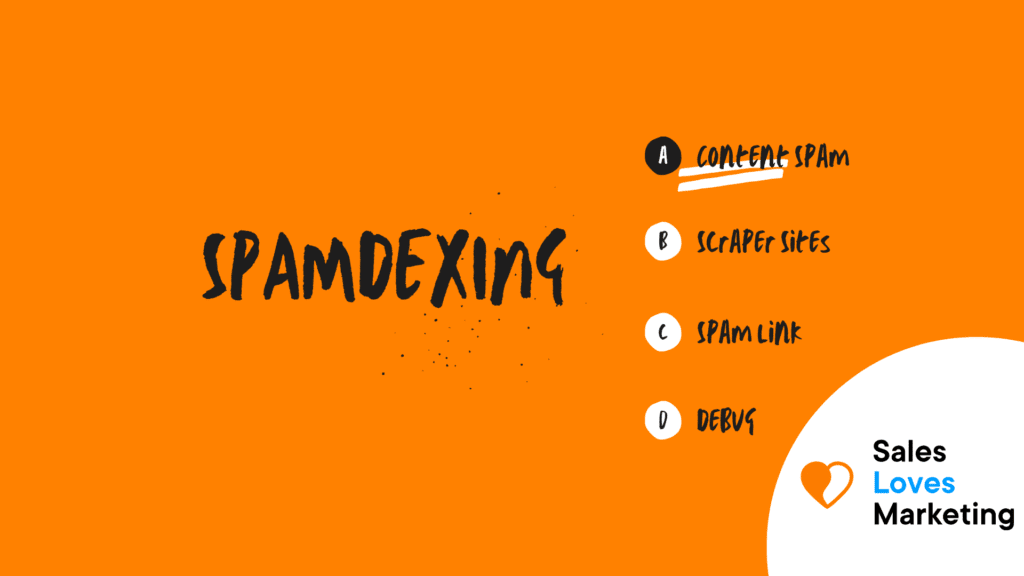What Is Spamdexing?
It is the harmful process of deliberately trying to manipulate search engine spiders and indexing engines to induce a website to appear in a prominent position or repeatedly in your search results. In the long run, it can have a serious negative impact on your website.
What Are The Types Of Spamdexing?
Content spam
- They consist of changing the logical perspective that a search engine has on the information on a page.
- Doorway pages are poor quality web pages with very little content packed with keywords and similar phrases.
- Scraper sites are made using multiple applications programmed to “scrape” search engine results pages or other sources of information and generate “content” for a website.
- Meta tag filling consists of multiple repetitions of keywords in the meta tags and the use of meta keywords that have nothing to do with the information on the site.
- Keyword stuffing is the deliberate placement of keywords within a web page to increase the page’s keyword count, density, and variety.
- Invisible or hidden text that is unrelated and disguised by matching its color to the web page’s background color, using a small font size, or hiding it within encoding.
- Rotating or rotating articles consists of rewriting already created articles instead of “scraping” information from other sites to avoid penalties imposed by search engines for duplicate content.
Spam link
They are links between pages that exist for reasons other than deserving them. It benefits from link-based ranking algorithms, which makes websites rank higher while more highly ranked websites link to it.
- Wiki spam is a form of link spam on wiki-type pages. The spammer uses the open editing feature of wiki systems to link from the wiki site to the spam website.
- Private Blog Networks (PBNs) are several authoritative websites grouped together that are used as a source of contextual links that point to the owner’s main website to gain a better ranking in search engines.
- Hidden links consist of placing hyperlinks invisible to users to increase the popularity of the links.
- The Sybil attack is the spoofing of multiple identities for malicious purposes, such as creating multiple web pages on different domain names that link to each other.
- Cookie filling consists of placing a cookie to follow affiliates on a website user’s computer without their knowledge and consent, which will create profits for the person who does the cookie filling.
- Spam blogs are made only for commercial purposes and to convey the authority of links to the target websites. They generally give the feel of a real website but are often made with rotating software or are poorly written with unreadable content.
- Link farms consist of very close networks of web pages that link to each other for the sole purpose of modifying search engine ranking algorithms.
How To Remove Spam And Protect A Website?
One way to find out about a Google fine is by using the “Manual Actions” and “Search Traffic” functions of the Google Search Console.
In case of suspicions, a spam report should be submitted. Google encourages anyone who witnesses dishonest techniques to artificially increase PageRank to immediately notify Google’s web spam team to help fight spam indexing.
Basic security measures must also be taken to remedy any weakness in the website; among some of these measures we have:
- Manage anti-spam tools.
- Have spam debugging.
- Use Google notices as much as possible to inspect a site to help detect hacked pages or discover fraudulent content.
- Use Chrome extensions to warn off spam and help fight spam.
- Using the noindex robots meta tag in posts to block non-search trackers and discourage spammers.
- Use the “disavow backlinks” option to remove fraudulent or low quality links that point to the site.
- Use a web program firewall (WAF) if you want to prevent the spread of spam in search engines.
- Monitor backlinks and locate “spam problems” or any abnormal patterns in links through Google Search Console.
- Use the “nofollow” attribute to persuade spammers to go to a site and give you more control.
How To Avoid Spamdexing On A Website?
To get rid of spamdexing, you should consider the following:
- Keyword stuffing should not be used.
- Perform keyword research and add only the most important and appropriate keywords and phrases in the headings, meta, and the rest of the body only when it is really relevant to the user.
- Create and add alternative attributes in content.
- Make a solid backlink strategy.
- Add internal links so that readers stay within the site and link them to intelligent information.
- Create and submit the site map.
Get started yourself with SEO with this all-in-SEO tool.
